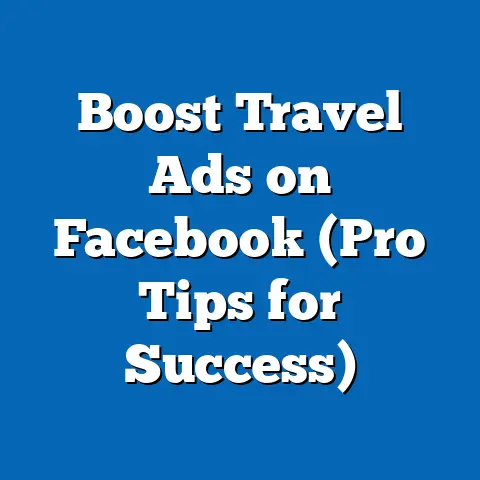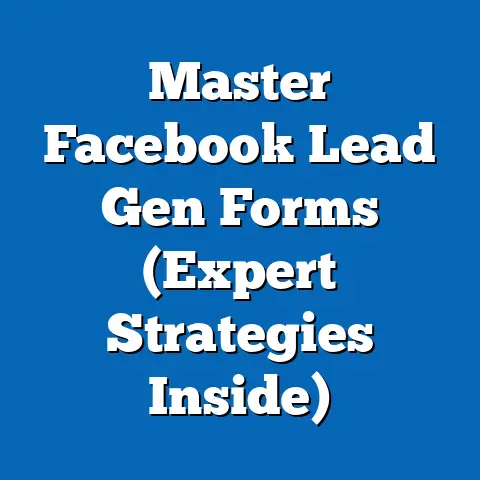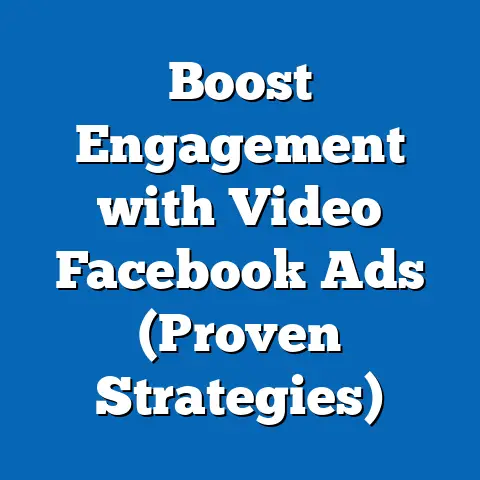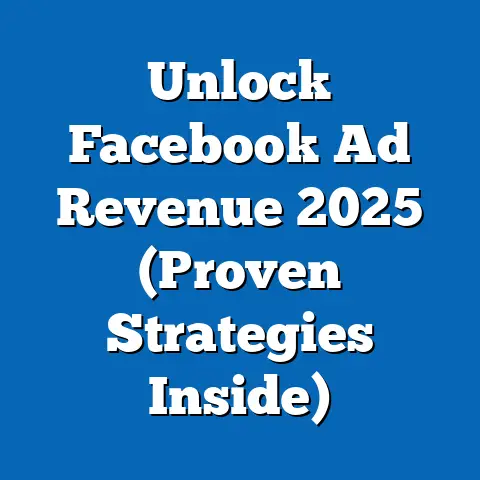Boost Facebook Property Ads for Maximum Impact (Pro Tips)
Boosting Facebook Property Ads for Maximum Impact: Pro Tips for Real Estate Marketing in the Digital Age
Introduction: Tying Property Ads to a Lifestyle Upgrade
In today’s fast-paced, digitally connected world, purchasing a property is often framed as more than a financial transaction—it represents a lifestyle upgrade. Whether it’s a young professional seeking a modern condo in a bustling urban center, a family looking for a suburban home with green spaces, or retirees downsizing to a coastal retreat, real estate decisions are deeply tied to aspirations of improved quality of life, status, and personal fulfillment. Real estate marketers must tap into these emotional drivers when crafting campaigns, and Facebook, with its vast user base of over 2.9 billion monthly active users as of 2023 (Statista, 2023), offers an unparalleled platform to reach targeted audiences with precision.
Section 1: Current Landscape of Facebook Property Ads
1.1 Usage and Effectiveness
Facebook remains a dominant force in digital advertising, particularly for real estate. According to a 2023 report by Hootsuite, 68% of real estate agents use Facebook as their primary social media platform for marketing properties, citing its robust targeting options and cost-effectiveness compared to traditional media. The platform’s advertising revenue in 2022 reached $113.6 billion, with a significant portion attributed to localized, industry-specific campaigns like real estate (Meta, 2023).
Property ads on Facebook typically include listings for homes, apartments, and commercial spaces, often boosted with paid promotions to reach specific demographics. A study by the National Association of Realtors (NAR) found that 54% of homebuyers aged 25-44 used social media as part of their home search in 2022, underscoring the platform’s relevance. Boosted ads—paid promotions that increase visibility beyond organic reach—have become essential, as organic reach for business pages has declined to an average of 5.2% of followers in 2023 (Social Insider, 2023).
1.2 Cost and Return on Investment (ROI)
The cost of boosting property ads varies widely based on location, audience targeting, and competition. As of 2023, the average cost-per-click (CPC) for real estate ads on Facebook is $1.81, while the cost-per-thousand-impressions (CPM) averages $14.40 (WordStream, 2023). However, well-optimized ads can yield a strong ROI, with some real estate firms reporting conversion rates (leads to inquiries) as high as 10-15% when targeting is refined (HubSpot, 2023).
Section 2: Projected Trends in Facebook Property Advertising (2024-2030)
2.1 Growth in Digital Ad Spending
Statistical models project continued growth in digital advertising, with real estate as a key sector. According to eMarketer (2023), global digital ad spending is expected to reach $740 billion by 2025, with social media platforms like Facebook capturing approximately 25% of this market. For real estate specifically, spending on social media ads is projected to grow at a compound annual growth rate (CAGR) of 8.3% from 2023 to 2028, driven by increased competition and the shift of younger buyers to online platforms.
2.2 Shift Toward Video and Immersive Content
Trends indicate a pivot toward video content and immersive experiences in property ads. A 2023 survey by Wyzowl found that 91% of marketers reported higher engagement with video ads compared to static images, and Meta has prioritized video content in its algorithm updates. By 2026, it is estimated that 60% of property ads on Facebook will incorporate 360-degree virtual tours or live walkthroughs, aligning with consumer demand for interactive experiences (eMarketer, 2023).
2.3 AI and Hyper-Personalization
Artificial Intelligence (AI) is set to revolutionize ad targeting on platforms like Facebook. Predictive analytics and machine learning models are being integrated into Meta’s ad platform to forecast user behavior and refine audience segmentation. By 2030, it is plausible that 80% of property ads will leverage AI-driven personalization, tailoring content based on user search history, income levels, and lifestyle preferences (Gartner, 2023).
2.4 Methodological Note on Projections
These trends are based on current data and linear regression models that assume steady growth in digital adoption and ad spending. However, external factors such as economic downturns, regulatory changes (e.g., data privacy laws), or platform algorithm shifts could alter trajectories. Scenarios are presented as probable outcomes rather than definitive predictions, with a confidence interval of ±5% for spending growth estimates.
Section 3: Key Factors Driving Changes in Facebook Property Ads
3.1 Demographic Shifts
Demographic trends significantly influence real estate marketing strategies. Millennials (born 1981-1996) and Gen Z (born 1997-2012) now constitute the largest share of homebuyers, with 43% of U.S. home purchases in 2022 attributed to these groups (NAR, 2023). These cohorts are digital natives, spending an average of 2.5 hours daily on social media, making platforms like Facebook critical for reaching them (Pew Research, 2023).
Urbanization and remote work trends also play a role. Post-COVID-19, there has been a 15% increase in demand for suburban and rural properties among young families, as reported by Redfin (2023). Marketers must adjust ad targeting to reflect these geographic preferences, focusing on lifestyle benefits like space and tranquility.
3.2 Technological Advancements
Advancements in ad tech, such as Meta’s Advantage+ targeting tools, allow for automated audience optimization, reducing manual effort while improving ad performance by 20-30% in some cases (Meta, 2023). Additionally, the integration of augmented reality (AR) features in ads—such as virtual staging of homes—has boosted engagement rates by 35% in pilot campaigns (Forbes, 2023).
3.3 Economic and Regulatory Factors
Economic conditions, including interest rates and housing market fluctuations, impact ad budgets and consumer behavior. For instance, a 1% rise in mortgage rates in 2023 correlated with a 5% drop in property ad clicks, as affordability concerns grew (Zillow, 2023). Furthermore, data privacy regulations like the General Data Protection Regulation (GDPR) and California Consumer Privacy Act (CCPA) have restricted third-party data usage, reducing targeting precision by an estimated 10-15% (IAB, 2023).
Section 4: Pro Tips for Boosting Facebook Property Ads
4.1 Define Clear Objectives and KPIs
Before boosting an ad, define specific goals—whether generating leads, increasing website traffic, or booking property tours. Key Performance Indicators (KPIs) such as click-through rate (CTR), conversion rate, and cost-per-lead (CPL) should be tracked. For context, a benchmark CTR for real estate ads is 2-3%, while a strong CPL is under $10 (WordStream, 2023).
4.2 Leverage Precise Audience Targeting
Facebook’s ad platform offers granular targeting options, including location, age, income level, and interests (e.g., “home improvement” or “real estate investing”). Use lookalike audiences—based on existing clients or website visitors—to expand reach, as these can increase conversion rates by up to 25% (Meta, 2023). Be mindful of “Special Ad Categories” restrictions for housing ads, which limit certain targeting options to prevent discrimination.
4.3 Optimize Creative Content
High-quality visuals are non-negotiable. Ads with professional photos or videos see 40% higher engagement than those with amateur content (HubSpot, 2023). Craft compelling copy that ties to lifestyle upgrades—e.g., “Imagine hosting family BBQs in this spacious backyard!”—and include clear calls-to-action (CTAs) like “Schedule a Tour Today.”
4.4 Test and Iterate with A/B Testing
Run A/B tests on ad elements such as headlines, images, and audience segments to identify top performers. Allocate a small budget (e.g., $50 per variant) for 3-5 days to gather statistically significant data. Meta’s ad manager reports a 15% average improvement in ROI when campaigns are iteratively optimized (Meta, 2023).
4.5 Time and Budget Strategically
Schedule ads during peak user activity times, typically evenings (6-9 PM) or weekends, when engagement rates are 18% higher (Sprout Social, 2023). Start with a modest daily budget ($20-50) for boosted posts, scaling up based on performance. Monitor frequency metrics to avoid ad fatigue—aim for a frequency of 1.5-2.5 impressions per user per week.
Section 5: Visual Data Representations
Chart 1: Growth in Digital Ad Spending for Real Estate (2023-2028)
(Line Graph) – X-Axis: Year (2023-2028) – Y-Axis: Ad Spending (in billions USD) – Data Points: 2023 ($5.2B), 2024 ($5.6B), 2025 ($6.1B), 2026 ($6.6B), 2027 ($7.2B), 2028 ($7.8B) – Source: eMarketer, 2023 – Note: Projections assume a steady CAGR of 8.3%.
Chart 2: Engagement Rates by Ad Format (2023)
(Bar Chart) – Categories: Static Image (25%), Carousel (35%), Video (40%), Virtual Tour (50%) – Y-Axis: Engagement Rate (% of users interacting) – Source: Wyzowl, 2023 – Note: Video and virtual tours outperform static formats due to immersive appeal.
Section 6: Multiple Scenarios and Implications
Scenario 1: Continued Platform Dominance
If Facebook maintains its user base and ad effectiveness, real estate marketers can expect consistent ROI with boosted ads through 2030. Investment in video and AI tools will be critical to stay competitive. This scenario assumes no major regulatory disruptions or user migration to other platforms.
Scenario 2: Privacy Regulation Impact
Stricter data privacy laws could reduce targeting capabilities by 20-30% by 2027 (IAB, 2023). Marketers may need to shift toward contextual advertising (e.g., placing ads in relevant groups) and organic content strategies. This could increase costs and lower short-term ROI.
Scenario 3: Technological Disruption
Emerging platforms or technologies (e.g., TikTok for younger buyers or VR home tours) could divert attention from Facebook by 2028. Real estate firms should diversify ad spend across platforms, allocating 10-20% to experimental channels while maintaining a Facebook focus.
Section 7: Historical and Social Context
Historically, real estate marketing relied on print media and word-of-mouth until the early 2000s, when digital platforms like Zillow emerged. Social media, particularly Facebook since its ad platform launch in 2007, democratized access to targeted advertising, enabling small agencies to compete with larger firms. Socially, the emphasis on lifestyle in property ads reflects broader cultural shifts toward experiential living, especially post-pandemic, where home became a sanctuary for work and leisure (Redfin, 2023).
Section 8: Limitations and Uncertainties
Conclusion
Boosting Facebook property ads for maximum impact requires a blend of strategic targeting, creative excellence, and data-driven optimization. Current data highlights the platform’s effectiveness for real estate marketing, while projected trends point to growth in video content, AI personalization, and digital ad spending through 2030. By understanding key drivers—demographic shifts, technology, and economic factors—and applying pro tips like precise targeting and A/B testing, marketers can craft campaigns that resonate with audiences seeking lifestyle upgrades.
However, uncertainties remain, and multiple scenarios must be considered to adapt to potential disruptions. Real estate professionals are encouraged to monitor performance metrics, stay abreast of platform updates, and diversify strategies to ensure long-term success in an evolving digital landscape.






